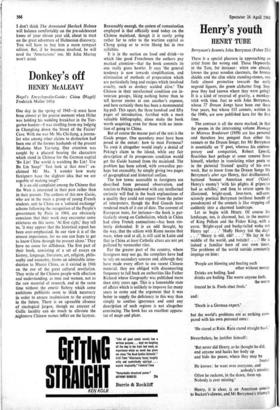Donkey's off
HENRY McALEAVY
One day in the spring of 1945—it must have been almost at the precise moment when Hitler was holding his wedding breakfast in the Tier- garten bunker—I was strolling from my lodging in Chungking down the Street of the Fairies' Cave. With me was Mr Ma Chi-liang, a journa- list who among other claims to distinction had been one of the former husbands of the present Madame Mao Tse-tung. Our attention was caught by a placard bearing the characters which stand in Chinese for the German capital 'Bo Lin! The world is watching Bo Lin! Use Bo Lin Soap!' Just look at that now!' ex- claimed Mr Ma. 'I wonder how many foreigners have the slightest idea that we are capable of making soap?'
It is an old complaint among the Chinese that the West is interested in their past rather than in their present. The authors of this new Guide, who are in the main a group of young French students sent to China on a 'cultural exchange' scheme following the recognition of the People's government by Paris in 1964, are obviously conscious that their work may encounter some strictures on this score. 'At first sight,' they tell us, 'it may appear that the historical aspect has been over-emphasised. In our view it is of the utmost importance, for no one can hope to get to know China through the present alone.' They have no cause for diffidence. The first part of their book, consisting of a set of essays on history, language, literature, art, religion, philo- sophy and economy, forms an admirable intro- duction to Maoist China, as it existed in 1966 on the eve of the great cultural revolution. They write of the Chinese people with affection and understanding, as men and women, not as the raw material of research, and at the same time without the emetic flattery which some ambitious publicists seem to think necessary in order to ensure readmission to the country in the future. There is an agreeable absence of sinological jargon, though no amount of Gallic lucidity can do much to alleviate the ,nightmare Chinese names inflict on the layman. Reasonably enough, the system of romanisation employed is that officially used today on the Chinese mainland, though it is surely going rather far to refer to the wartime capital as Chong quing or to write Shang hai in two syllables.
It is in the section on food and drink—to which like good Frenchmen the authors pay marked attention—that the book commits its one really gross howler. It says 'the general tendency is now towards simplification, and elimination of methods of preparation which are particularly long and recipes which involved cruelty, such as donkey scalded alive.' The Chinese in their unreformed condition are in- veterate gossips, liking nothing better than to tell horror stories at one another's expense, and here certainly there has been a monumental leg-pull. This apart, the three hundred and fifty pages of introduction, fortified with a most valuable bibliography, alone make the book worth acquiring, even for those with no inten- tion of going to China.
But of course the master part of the text is the Guide proper. One quandary must have been posed at the outset: how to treat Formosa?
To omit it altogether would imply a denial of Peking's claim to the island, while any fair description of its prosperous condition would get the Guide banned from the mainland. The problem has been solved, with cowardice per- haps but excusably, by simply giving two pages of geographical and historical outline.
The few towns accessible to foreigners are described from personal observation, and tourists to Peking endowed with any intellectual curiosity will find in the book explanations of a quality they could not expect from the patter of interpreters, though the Red Guards have rendered much of it out of date. The convent of European nuns, for instance—the book is par- ticularly strong on Catholicism, which in China had close French connections—has been vio- lently disbanded. It is an odd thought, by the way, that the schism with Rome means that mass, when said at all, is still said in Latin and that in China at least Catholic altars are not yet polluted by vernacular rites.
For the greater part of the country, where foreigners may not go, the compilers have had to rely on secondary sources and, although they have made every effort to use recent Chinese material, they are obliged with disconcerting frequency to fall back on authorities like Father Richard whose Geography was published more than sixty years ago. This is a lamentable state of affairs which is unlikely to improve for many years to come and the argument that it was better to supply the deficiency in this way than simply to confess ignorance and omit any description of such regions is not altogether convincing. The book has an excellent appara- tus of maps and plans.






































 Previous page
Previous page